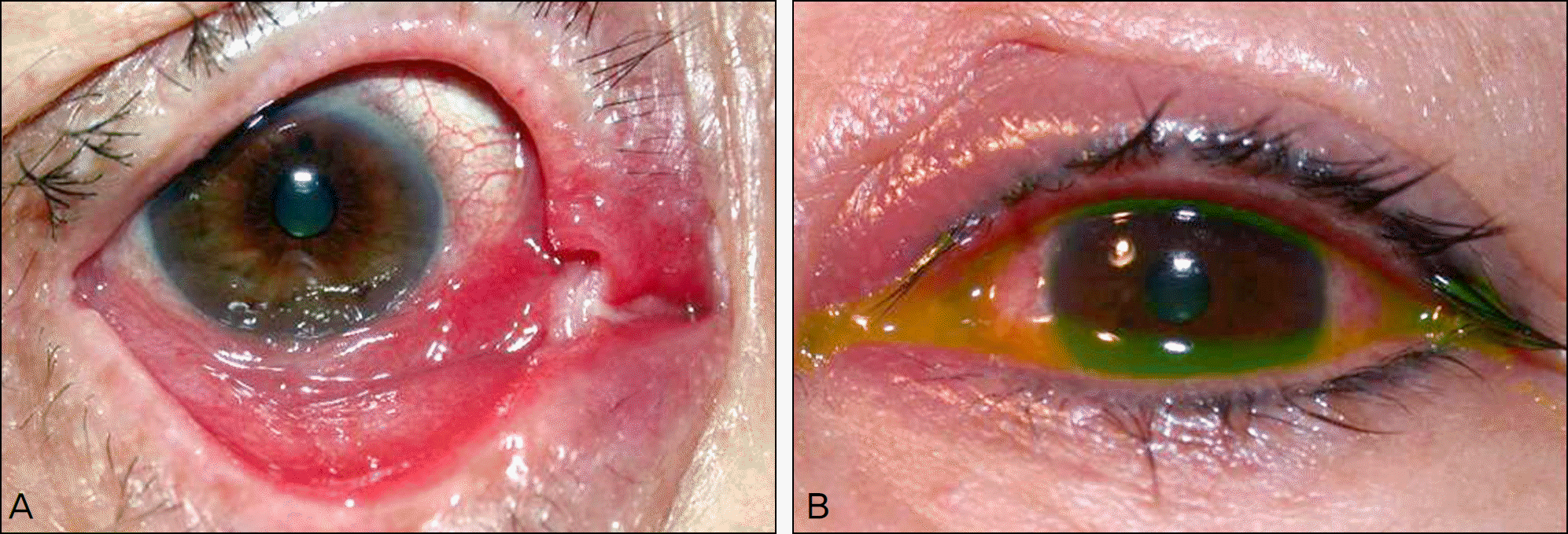Abstract
Purpose
To investigate the incidence and clinical course of acute conjunctivitis after endoscopic dacryocystorhinostomy (DCR) with silicone tube intubation.
Methods
A retrospective study was conducted on 547 eyes in 517 patients who had undergone endoscopic DCR with silicone tube intubation between 2005 and 2009. The onset, incidence and symptoms of acute conjunctivitis, the effect of silicone tube intubation on acute conjunctivitis, and the effect of acute conjunctivitis on the success rate of DCR were investigated.
Results
The incidence of acute conjunctivitis was 3.8%. The mean age of 21 patients with acute conjunctivitis was 52.6 ± 14.3 years and the mean follow-up period of those was 18.0 ± 6.4 months after surgery. All the cases of acute conjunctivitis were resolved with topical antibiotic treatment after silicone tube removal. The success rates between patients with and without conjunctivitis were not significantly different (80.95% and 88.97%, respectively; p = 0.282). However, 4 patients with surgical failure had a longer time from onset of acute conjunctivitis to the removal of the silicone tube than 17 patients with surgical success (0.22 months and 1.13 months, respectively; p = 0.047). A higher rate (76.2%) of conjunctivitis developed in patients with granuloma around the surgical ostium.
Conclusions
A correlation may exist between acute conjunctivitis and granuloma in patients with DCR with silicone tube intubation. Acute conjunctivitis did not appear to influence the surgical results, although a delayed timing of silicone tube removal in patients with conjunctivitis could decrease the success rate.
Go to : 
References
1. Rosen N, Sharir M, Moverman DC, Rosner M. Dacryocystorhinostomy with silicone tubes: evaluation of 253 cases. Ophthalmic Surg. 1989; 20:115–9.

2. Soll DB. Silicone intubation: an alternative to dacryocystorhinostomy. Ophthalmology. 1978; 85:1259–66.

3. Bedrossian RH. Silicone intubation of the lacrimal drainage system. Ophthalmic Surg. 1979; 10:39–44.
4. Quickert MH, Dryden RM. Probes for intubation in lacrimal drainage. Trans Am Acad Ophthalmol Otolaryngol. 1970; 74:431–3.
5. Snead JW, Rathbun JE, Crawford JB. Effects of the silicone tube on the canaliculus: an animal experiment. Ophthalmology. 1980; 87:1031–6.
6. Dresner SC, Codère F, Brownstein S, Jouve P. Lacrimal drainage system inflammatory masses from retained silicone tubing. Am J Ophthalmol. 1984; 98:609–13.

7. Anderson RL, Edwards JJ. Indications, complications and results with silicone stents. Ophthalmology. 1979; 86:1474–87.

8. Lauring L. Silicone intubation of the lacrimal system: pitfalls, problems and complications. Ann Ophthalmol. 1976; 8:489–98.
9. Sohn HY, Hur J, Chung EH, Won IG. Clinical observation on silicone intubation in obstruction of lacrimal drainage system. J Korean Ophthalmol Soc. 1990; 31:135–40.
10. Jordan DR, Nerad JA. An acute inflammatory reaction to silicone stents. Ophthal Plast Reconstr Surg. 1987; 3:147–50.

11. Ruby AJ, Lissner GS, O'Grady R. Surface reaction on silicone tubes used in the treatment of nasolacrimal drainage system obstruction. Ophthalmic Surg. 1991; 22:745–8.

12. Jung BY, Kim YD. Canaliculitis after dacryocystorhinostomy with silicone tubes. J Korean Ophthalmol Soc. 2008; 49:390–5.

13. Iliff CE. A simplified dacryocystorhinostomy. Trans Am Acad Ophthalmol Otolaryngol. 1954; 58:590–2.

14. Woog JJ, Metson R, Puliafito CA. Holmium:YAG endonasal laser dacryocystorhinostomy. Am J Ophthalmol. 1993; 116:1–10.
15. Older JJ. Routine use of a silicone stent in a dacryocystorhinostomy. Ophthalmic Surg. 1982; 13:911–5.

16. Allen K, Berlin AJ. Dacryocystorhinostomy failure: association with nasolacrimal silicone intubation. Ophthalmic Surg. 1989; 20:486–9.

17. Walland MJ, Rose GE. The effect of silicone intubation on failure and infection rates after dacryocystorhinostomy. Ophthalmic Surg. 1994; 25:597–600.

19. Katowitz JA. Silicone tubing in canalicular obstructions. A preliminary report. Arch Ophthalmol. 1974; 91:459–62.
20. Lee SH, Kim SD, Kim JD. Silicone intubation for nasolacrimal duct obstruction in adult. J Korean Ophthalmol Soc. 1997; 38:185–9.
Go to : 
Table 1.
Characteristics of patients with and without acute conjunctivitis after endonasal dacryocystorhinostomy with silicone tube intubation
| Acute conjunctivitis | p-value* | ||
|---|---|---|---|
| (+) (n = 21) | (−) (n = 526) | ||
| Age (mean ± SD, yr) | 52.6 ± 14.3 | 54.2 ± 16.2 | 0.648*† |
| Sex (M:F) | 6:15 | 126:400 | 0.604† |
| Follow-up period (mean ± SD, mon) | 18.0 ± 6.4 | 20.1 ± 9.1 | 0.392* |
| Tube removal (mean ± SD, mon [range]) | 3.6 ± 1.0 (1.75–5.5) | 5.9 ± 0.2 (5.0–6.0) | <0.001* |
Table 2.
Timings of silicone tube removal and success rates according to onset of acute conjunctivitis after endonasal dacryocystorhinostomy
| Onset of acute conjunctivitis after endonasal DCR | p-value | ||
|---|---|---|---|
| <3 mon (n = 6) | >3 mon (n = 15) | ||
| Tube removal (mean ± SD, mon)* | 0.83 ± 0.75 | 0.22 ± 0.28 | 0.106† |
| Success rates (% [eye]) | 66.7 (4/6) | 86.7 (13/15) | 0.544† |




 PDF
PDF ePub
ePub Citation
Citation Print
Print



 XML Download
XML Download